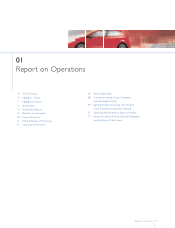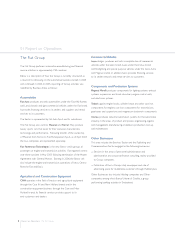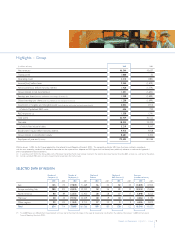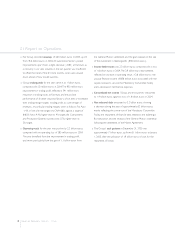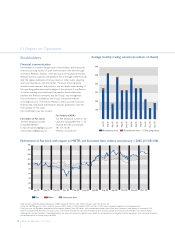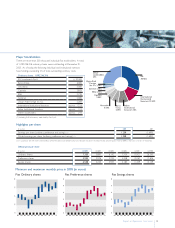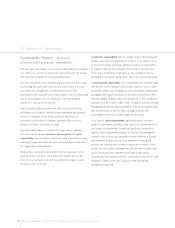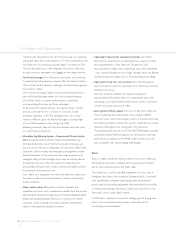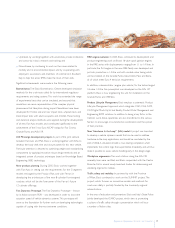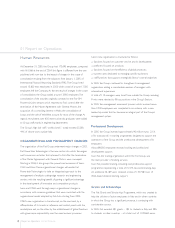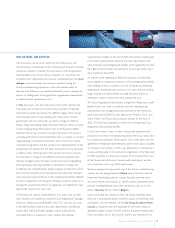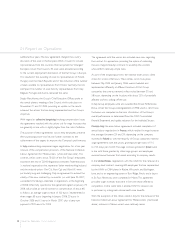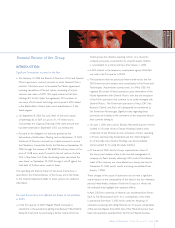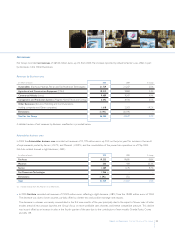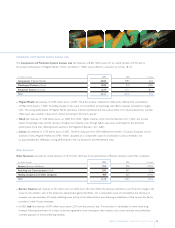Chrysler 2005 Annual Report Download - page 17
Download and view the complete annual report
Please find page 17 of the 2005 Chrysler annual report below. You can navigate through the pages in the report by either clicking on the pages listed below, or by using the keyword search tool below to find specific information within the annual report.
16 Reporton Operations Research and Innovation
01 Report on Operations
The floor pan, derived from the 4x4 version, houses two separate
natural gas tanks with a total capacity of 70 litres. Compared to the
Fiat Punto now in production, cruising range is increased by 20%.
The two fuel tanks are so well integrated that the car offers just
as much room for passengers and luggage as the original version.
Fiat Panda Hydrogen.The Orbassano laboratories are continuing
to develop fuel cell propulsion systems. After the Seicento Elettra
H2 Fuel Cell and the Seicento Hydrogen, the Panda Hydrogen has
now made its debut.
With the fuel cell engine neatlystowed away beneath the floor
pan, the Panda Hydrogen retains all of the distinctive features
of the New Panda’s occupant compartment, comfortably
accommodating the driver and three passengers.
At full power, the vehicle reaches a top speed of over 130 kph
and can accelerate from 0 to 50 kph in 7 seconds. Grade
driveaway capability is 23%.The hydrogen tank, with its total
volume of 68 litres, gives the Panda Hydrogen a cruising range
of over 200 kilometres in stop-and-go city traffic.
Refueling, moreover, takes less than five minutes: much the same
as a natural gas-powered car.
Infonebbia Fog Warning System – Experimental Torino-Caselle
link. During the Olympic Winter Games, the Infonebbia Fog
Warning System test site on the Torino-Caselle motorway was
put into service.The site is integrated with the Torino 2006 Traffic
Operative Centre mobility and emergency management system.
Several kilometres of the motorway have been equipped with
intelligent safety aids: technologies that check on visibility, devices
for keeping road usersinformed, systems for detecting and
announcing traffic jams and a control centre that handles wireless
monitoring for the entire test site.
Four “safety cars” equipped with radar and telematic systems ply
the road in order to provide assistance to driversin potentially
critical conditions.
Motor vehicle safety.Safety,both of vehicle occupants and
vulnerable road users such as pedestrians, benefits from the product
improvements achieved through the use of numerical/experimental
design and testing techniques that focus on crashworthy vehicle
structures as well as airbags, seat belts, occupant compartment
interiors and pedestrian protection systems.
Lightweight materials for commercial vehicles.The Centro
Ricerche Fiat assisted Iveco in developing new ways to increase
the competitiveness of the Daily line.The goal for 2005 –
reducing vehicle weight without penalising costs and investments
–was reached through the use of high strength steels and flexible
manufacturing technologies such as hydroforming and profiling.
High performance thin seat structure.The C.R.F. developed a
new front seat structure for subcompact cars featuring a low-bulk
seatback and cushion.
With this structure, seatback and cushion padding are
approximately50% thinner than on a conventional seat, while
continuing to provide excellent performance in terms of postural
comfort and active and passive safety.
Spark ignition Multiair engine.The work of the Centro Ricerche
Fiat on optimising the performance of the original UNIAIR
electronic valvecontrol technology in terms of feasibility and costs
has made it possible to extend this system’sapplications to include
medium-small engines, thus cutting their CO2emissions.
The preproduction version of the Fire MULTIAIR engine has been
successfully tested, demonstrating its low consumption and high
performance. In addition, the UNIAIR system turned out to be
fully compatible with turbocharging technologies.
Elasis
Elasis is a highly specialised research centre whose work addresses
technological innovation, complete vehicle development, mobility
and its environmental impact, and traffic safety.
The Centre has a staff of over 800 employees at its two sites in
Pomigliano and Lecce, both located in Southern Italy. It is provided
with sophisticated computer-aided design tools and advanced
physical and virtual testing equipment which are based on an ability
to develop and manage information systems that puts Elasis in the
front ranks of the world’sR&D centres.
In 2005, Elasis continued to pursue its strategic goal of forging new
links in the research/innovation system’s value chain and of
promoting local development:



